| In his
previous two adventures the Batman had pretty much been a
hardboiled vigilante who grappled with ordinary criminals
and gangsters. What was extraordinary about the character
was his surreal costume, and 28-year old Gardner Fox
intended to close the gap and inject a similarly
fantastic element into the story itself. |
| |
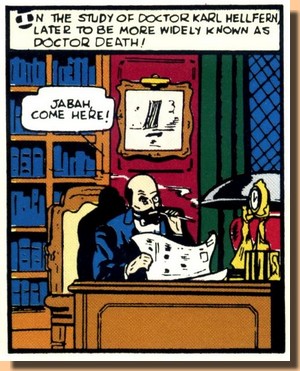
|
|
Whereas
Finger had dealt with 6 pages previously,
this was now up to 10 as of this issue,
but this was certainly no problem for Fox
who jumped straight into his story about "Doctor
Karl Hellfern, later to be more widely
known as Doctor Death!" This was an instant
departure from thieves and gangsters who
were out to steal documents or jewellery
and who went by names such as Alfred
Stryker or Frenchy Blake - here was a
much more refined criminal (a doctor,
after all) whose name signalled both a
mystery and a terrible threat at the same
time... clearly, this was an evil
mastermind, not just some street level
criminal.
It set a decisively
new tone - and changed the gameplay for
Batman forever as Gardner Fox plotted the
vigilante against his first true villain
with a masterplan: Doctor Death. The
story itself has its fair share of
contrived coincidences and lapses of
logic (as indeed many of Fox's comic book
stories do) but the plot induces an
astonishing number of defining elements
for the first time - pillars of the
Batman mythos which subsequent writers
would revisit time and time again.
|
|
|
| |
| Doctor Karl
Hellfern has completed his experiments on producing a
death bringing pollen extract and is now ready to
blackmail the wealthy of the world by threatening to use
his invention on them. However, he is acutely aware of
the fact that he needs to eliminate the Batman before
seeing his actual scheme go through successfully, and for
such purposes Doctor Death is assisted by a large East
Indian manservant named Jabah. |
| |
| However, Doctor
Death's attempt to set a trap for the
Batman by averting him of an imminent
murder fails - Jabah (who tells Batman
that "Doctor Death sends his
greetings"...) shoots and
wounds the Batman but the masked
vigilante in turn uses his choking gas
pellets and is thus able to make his
getaway. Doctor Death decides to go ahead
with his murderous plans nonetheless but
is found out by the Batman and drops a
test tube with a highly flammable
substance, and as the flames blaze around
him in his laboratory he begins to laugh
madly. |
|
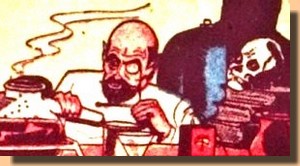 |
|
|
| |
| The Batman
turns from the scene and solemnly remarks -- "Death...
to Doctor Death" ... the final panel, however,
asks "BUT IS IT DEATH TO THIS ARCH
CRIMINAL ? FOLLOW THE FURTHER AMAZING AND UNIQUE
ADVENTURES OF THE BAT-MAN" |
| |
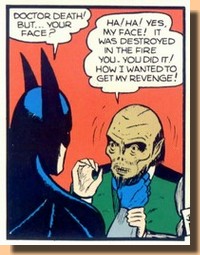
|
|
Not surprisingly,
therefore, Detective Comics #30
reveals that Doctor Death managed to
escape the flames through a hidden
trapdoor, albeit at the price of now
having a hideously disfigured face. With
a new accomplice, a Cossack named
Mikhail, Doctor Death is successful in
claiming a victim in his extortion
scheme, but Batman defeats the Doctor's
plans in the end and turns him over to
the police. Over
the course of a mere two consecutive
issues of Detective Comics Gardner
Fox set up and used plot elements which
would become pivotal and defining for the
Batman and his world - and the superhero
mythos in general.
Literally first off -
in panel one of the story - readers sense
that this time around the Batman will
have to face not just a criminal but a
foe, one who is as much outside of the
regular and the ordinary as indeed the
Batman himself.
|
|
|
| |
| The signal
token for this is having a chosen name - not just a false
name, but one that carries symbolic meaning, and it works
precisely the same way for both sides involved. It is not
Bruce Wayne against Doctor Karl Hellfern - no, it's Batman
versus Doctor Death. |
| |
| This was, of
course, a well established device
in pulp fiction, where both the
heroes and the evil villains
assumed almost trademark names -
and not surprisingly, there was
indeed a pulp magazine Doctor
Death published by Dell in
1935 (it only lasted for three
issues) featuring as main
character an archetypal mad
scientist by that name. So whilst
Gardner Fox was - like others -
once again borrowing heavily from
pulp fiction (including the idea of
giving Batman a utlity belt
(introduced by Fox in Detective
Comics #29) which according
to Tollin (2007) came straight
from the Shadow pulps), his use
of this source of inspiration
produced novel effects in the
still young medium of comic
books. Only one
month prior to Detective
Comics #29 Jerry Siegel had
introduced Superman's first
"supervillain" in Action
Comics #13 (June 1939): the
"Ultra-Humanite", a criminal
mastermind who has a crippled
body but a highly advanced
intellect and who is set on
gaining world domination.
|
|
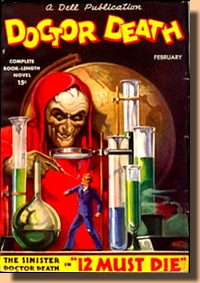 |
|
|
|
| |
| So in terms of pure
chronology Siegel beat Fox to introducing the concept to
the world of comic books that superheroes are only really
put to the test by supervillains. It is likely that Fox
knew about the Ultra-Humanite, but his version of a mad
scientist villain would, with hindsight, fit the
Darknight Detective's world like a glove. |
| |
Being an unscrupulous
scientist with a narrow field of
specialization rather than the "most
agile and learned brain on Earth"
(as Siegel described the Ultra-Humanite)
gave him that tinge of actually being
possible in the real world - a trait
which has come to set apart Batman from
virtually all superheroes. Rather than
going for superlatives Fox instinctively
knew where to hold back and where to go
all out: Shakespeare may have been right
that a rose by any other name would smell
just as sweet, but when it comes down to
villainous threats, Doctor Death
is just the ticket. It is almost a shame
that the distinction of being the first
ever comic book supervillain goes to the
ultra-lame Ultra-Humanite and not Doctor
Death.
Another
important point was Doctor Hellfern being
acutely aware of the fact that the Batman
poses a real threat to his plans and
therefore needs to be taken care of
first. As simple as this
plot device may be, it is in fact a
fundamental cornerstone of the superhero
comic book genre which has driven
countless storylines. Its importance lies
in the effect of creating a relationship
between the hero and the villain and
taking the conflict to a meta level where
the villain is not just a common
criminal, but rather a supervillain
challenging the superhero who is
the one and only standing between him and
the success of his nefarious plans.
Gardner Fox could hardly have foreseen
it, but ultimately this would even turn
into the confrontation being the actual
purpose of the villain, so that he might
prove himself superior to the hero - and
even further down the road it would lead
to a complex and existential interaction
between the antagonists: what, after all,
is the Joker without a Batman, and
possibly vice versa too?
Amother important
trait of the supervillain introduced into
the world of Batman with Doctor Death is
the diabolical scheme, the evil
masterplan. In the case of Dr Hellfern
the ultimate goal is unclear, but his
blackmailing scheme takes on a sinister
quality by way of the means applied if
his threats are ignored. Later updates of
Doctor Death would illustrate fully the
gruesome potential Hellfern's chemical
threats can take on - ultimately making
him a dabbler in chemical warfare and
mass destruction. But even in the
somewhat sketchy narrative style of
Gardner Fox Doctor Death clearly is the
first real "Batman villain" (as
he, typically, also sets out to do away
with the Caped Crusader) - the first in
what would become a long line of
characters.
The story per se is
neither consistent nor truly gripping,
but the details which Fox worked into it
make it fly all the same as he also
underlines the importance of Batman's
special equipment and readers learn for
the first time what the Batman actually
puts away in his utility be.
"Gardner
Fox was (...) not the greatest
writer, but very capable and
reliable, a good plot man."
(long-time DC
editor Julius Schwartz, in Schwartz
& Thomsen, 2000)
|
|
GARDNER
FOX
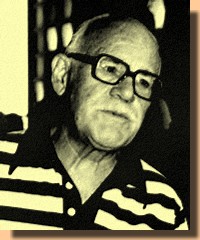
Gardner
Francis Cooper Fox (May 20th 1911 - December 24th 1986) was a prolific
comic book writer and creator who is
estimated to have written over 4,000
stories for the medium - plus an average
of three books per year between 1944 and
1982. He received a law degree from St.
John's College (New York) and was
admitted to the New York bar in 1935, but
as the ill economic effects of the Great
Depression continued to be felt he began
writing for DC Comics under editor Vin
Sullivan (an old school friend) as of
mid-1937. His first story featured Speed
Saunders in Detective Comics #4
(September 1937) and throughout the
following years Fox would contribute
stories to nearly every book in the DC
Golden Age lineup. He was a master when
it came to defining the specifics of a
certain character and providing that
persona with a unique aura, and his
ingenuity was virtually second to none.
On the storytelling level, the quality of
his output was less consistent. Fox
created or co-created several well-known
Golden Age comic book characters, such as
The Sandman (1939), The Flash (1940) and
Hawkman (1940), and came up with the
concept of the Justice Society of America
- the first comic book superhero team -
in late 1940. From 1947 to 1950 Fox also
wrote stories for EC Comics and their
famous line of horror comics such as Crypt
of Terror and Vault of Horror.
Following the crackdown on the comic book
industry in the wake of Fredric Wertham's
Seduction of the Innocent in the
mid-1950s, Julius Schwartz called in
Gardner Fox to assist with the revival of
DC's Golden Age heroes. The two men
revamped the characters, giving them new
costumes and backgrounds, and Fox
introduced the concept that the Golden
Age heroes existed on a parallel Earth in
The Flash #123 in September 1961
- setting up the DC multiverse.
|
|
|
| |
| Very
importantly Fox also casts the mould for the return of
countless villains from what seemed to be certain death -
in this case thanks to a hidden trap door. And whilst Fox
thus shows that the death of villains in comic books
should never be taken to be a permanent departure, the
"return from the dead" more often than not
comes at a price - in this case in the form of a
hideously disfigured face. The end for Doctor Death's evil
schemes as well as himself comes rather humiliatingly in Detective
Comics #30: The Batman simply ties him up and leaves
him to be picked up by the police, complete with a card
reading "MEET DOCTOR DEATH..."
|
| |
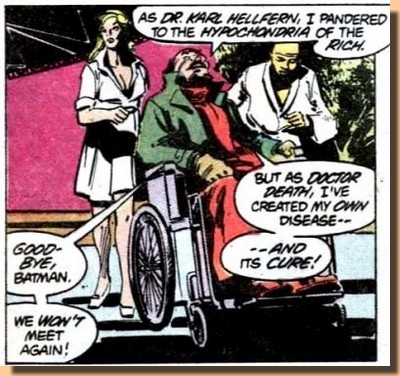 |
|
Doctor Death was Batman's
first real villainous antagonist, the first to
make a comeback (even though previously presume
dead), and the first to then disappear for more
than just one generation of readers before
finally being unearthed and rediscovered many
years later. In the case of Doctor Death
it took 43 years, to be exact. As the year 1982
rolled around, DC was bringing Batman
and Detective Comics closer by having
storylines continue from one title into the
other, and at the same time writer Gerry Conway
revisited the Darknight Detective's first year
and the villains he encountered back in 1939.
And
so Doctor Death was reintroduced to the Batman
Universe in Batman #345 (March 1982), with
the story continued and concluded fourteen days
later in Detective Comics #512 (March
1982).
|
|
| |
| In
"Calling Doctor Death" (Batman #345)
Conway updates the original 1939 tale and illustrates
nicely the potential the character has - aspects which
came across as being slightly (if not outright) cheesy in
Fox's storytelling are now seen to be viciously
threatening; while Doctor Death is depicted as being a
paraplegic bound to a wheelchair, his modus operandi as
well as his weapon - a deadly super-allergen dust -
remain the same. |
| |
| Conway introduces Dr Karl
Hellfern as a society Doctor Feelgood who pampers
the perceived little medical worries of many rich
and wealthy of Gotham but who actually is about
to set into action his plans - calling himself
Doctor Death - of extortion by releasing his
deadly super-allergen dust all over Gotham. And just as
he did back in 1939, Hellfern wants no
interference from Batman (who was sidekickless
back then but now has Robin fighting crime with
him) and focuses first on taking Gotham's
vigilante out of the game - permanently.
|
|
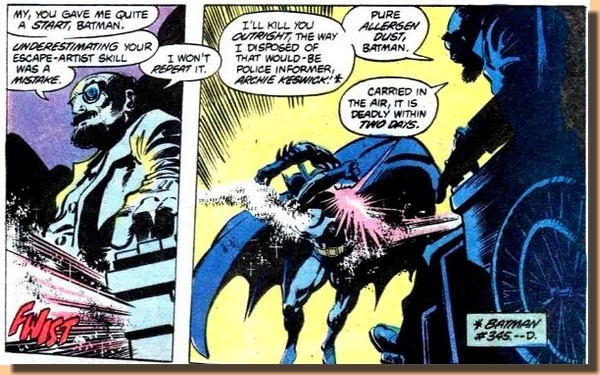 |
|
| |
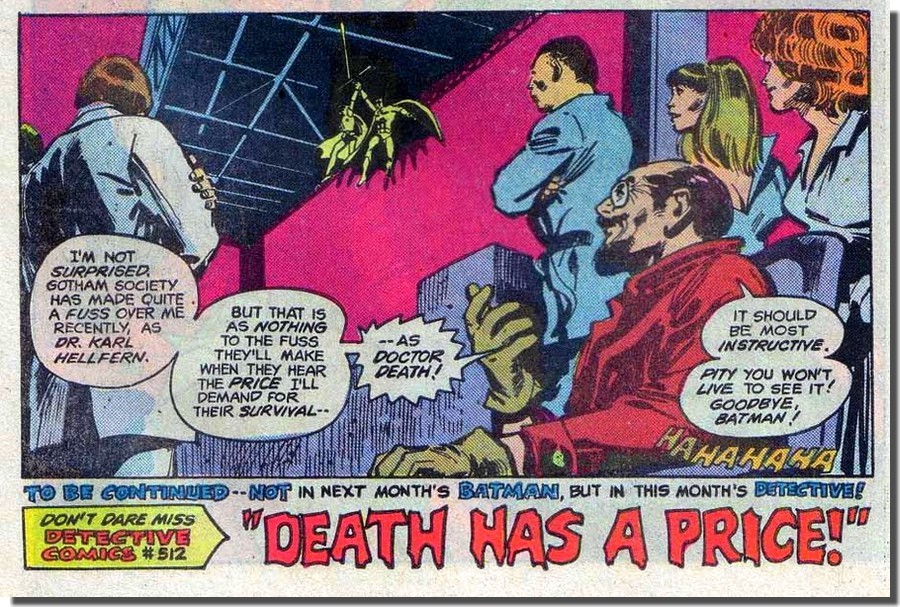 |
| |
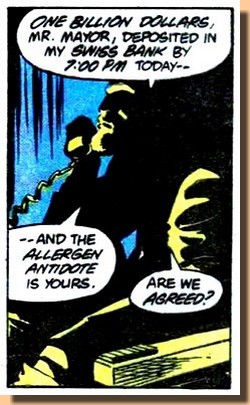
|
|
However,
the Darknight Detective escapes and
rounds up Doctor Death and his antidote
to the allergen dust he has already been
spraying all over Gotham. Ironically,
when Gotham is then covered from the air
with the antidote this causes a temporary
allergic reaction in Hellfern himself.
The exact fate of Doctor Death is not
depicted, although readers can infer that
he will be imprisoned. In a
clever and brilliantly executed bow to
the history of the Batman universe and
mythology, Gerry Conway took the
underlying potential of Doctor Death and
turned him and his evil plot of mass
destruction into a well paced, well
rounded and well told Batman story which
worked on every level - and the
mysterious figure of Dr Karl Hellfern was
well suited to Gene Colan's shadowy and
horroresque style.
Conway had Hellfern
bound to a wheelchair, and Colan's
rendition of the wheelchair's deadly
gadgets was every bit as intriguing and
menacing as his previous rendition of
Harker's famous wheelchair in Marvel's Tomb
of Dracula.
Interesting as
Conway's revival of Doctor Death was, it
was only a very brief return to the
limelights of the Batman Universe for Dr
Karl Hellfern - after Batman #345
and Detective Comics #512 he once
again returned to his previous state of
limbo.
|
|
|
| |
| He remained there for
another 21 years until writer Dylan Horrocks had him
reappear again, albeit this time facing Batgirl in her
own title. |
| |
| in
"Death in a Bottle" (Batgirl
#42, September 2003) Batgirl and
Batman together come across a
Russian Mafia arms dealer who is
in possession of a soda bottle
labelled Doctor Death.
Upon inspection of its contents
Alfred discovers that it contains
a
poison lethal enough to kill the
entire city. Tracking down the
possible sources of the bottle
leads to - Doctor Death, who is
seeking to auction off his poison
to the highest bidder. The story
continues through Batgirl
#44 and is concluded later in
issue #50 (May 2004) when Doctor
Death is once more arrested and
taken away by the police - by now
seemingly the routine way for him
to bow out.
Unlike
Gene Colan, who back in 1982 more
or less followed the 1939 visuals
while adding the depth of his
shadowy pencilling style, artist
Adrian Sibar changed the
appearance of Doctor Death
significantly, portraying him as
a bald, gnome-like man who wears
a lab coat and an oxygen mask.
|
|
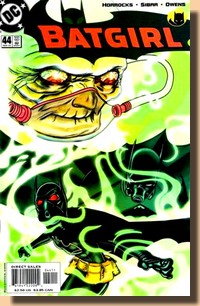 |
|
|
|
| |
| From there on, Doctor Death
did not have to wait just quite as long for his next
appearance, which came about in Batman #692
(December 2009) and following issues as writer/artist
Tony S. Daniel had him join forces with Black Mask.
Portrayed as a mad scientist in the truest sense of the
word, the plans of Doctor Death now seem reduced, to all
intent and purpose, to simply see his lethal products
successfully in action, whilst his true underlying
motives other than a seemingly endless contempt for
living beings remain blurred. The visuals are once again
evolved, now portraying Doctor Death as someone clad in a
thick overcoat, wearing a hat and gloves and, most
importantly, a gas mask. |
| |
|
| |
| An interesting take both in
terms of characterization and visuals, Doctor Death was
upgraded to be portrayed as a major destructive force in
the Batman Universe, unlocking the potential the
character had by definition always carried through his modus
operandi. |
| |
| When writer Scott Snyder
kicked off an eleven part story arc called "Zero
Year" in Batman #21 (September 2013) -
which was to serve as a "re-imagination" of the
formative years of Bruce Wayne and his early days of
waging war on crime as the Batman in the context of DC's
"New 52" - he set up the Red Hood Gang
(introduced in Batman: The Killing Joke [June
1988] and based on the Jokers' origin as "the Man
under the Red Hood" from Detective Comics
#168 [February 1951]) and Edward Nygma a.k.a. The Riddler
(first featured in Detective Comics #140
[October 1948]) as the Darknight Detective's first
antagonists. However, in Batman #25, (January
2014) Snyder also brought back Doctor Death - as well as
his alter ego Dr Karl Hellfern who, however, was now
portrayed as a former scientific researcher with Wayne
Industries. |
| |
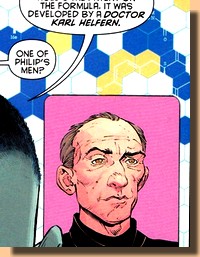 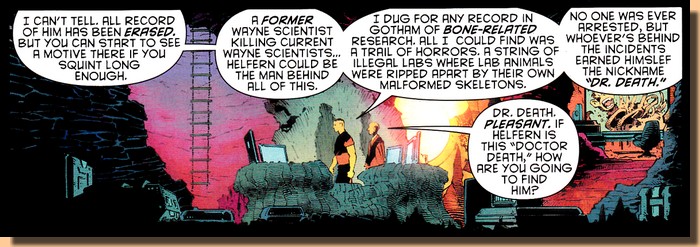 |
| |
| During his bone-related
research work Hellfern was trying to come up with a
formula which would inject self-healing and strengthening
characteristics into human bone tissue (the motive for
which is later discovered to lie with the death of his
son from wounds to the skull which he suffered during a
covert military operation in Nigeria). |
| |
| As Hellfern's
experiments turn nasty he is let
go by Wayne Industries but
continues his work in illegal
laboratories, and when the
Riddler takes over Gotham he
talks Hellfern into using his
substance on himself. The problem
with this is that it induces
uncontrollable bone growth and
distortion. The resulting
depiction of Doctor Death by
artist Greg Capullo has no
resemblance to any of the
previous visuals and, while
certainly dramatic, turns Doctor
Death into a ghoul more than
anything else. As such he loses
much of his down to earth and
therefore ultimately very real
threat, although his capability
of transfering his condition by
blood contamination (e.g. through
a scratch or, more likely, a stab
wound from his elongated boney
fingers) certainly makes him a
formidable foe and threat.
|
|
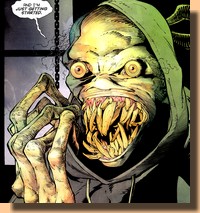 |
|
|
|
| |
| This time around, the end
is rather more final than in his previous bowing outs: in
Batman #29 (May 2014) Doctor Death is hit by
shrapnel from an explosion, and the resulting violent
"healing" reaction from his bone structure has
his body virtually exploding. It would definitely seem like the end
for Doctor Death - but then he already had readers
thinking that back in 1939, in Detective Comics
#29 ...
|
| |
|
| |
Bibliography
JONES
Gerard (2004) Men of Tomorrow, Basic Books /
Perseus
SCHWARTZ
Julius & Brian M. Thomsen (2000) Man of Two
Worlds, Harper
|
| |
| |
| |
BATMAN and all
related elements are the property of DC
Comics, Inc. TM and © DC Comics, Inc., a
subsidiary of Time Warner Inc.
The illustrations presented here are
copyright material. Their reproduction for
the review purposes of this website is
considered fair use as set out by the
Copyright Act of 1976, 17
U.S.C. par. 107.
|
|


